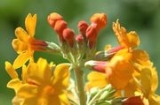
Primula bulleyana
Encyclopedia
Primula bulleyana is a species of Primula
, one of group known as candelabra primrose
s.
It was first introduced by George Forrest
from Yunnan province, China, in 1906, and named after Arthur K Bulley, his first sponsor, who was a cotton Broker from Liverpool and a keen amateur gardener. He founded the Bees Ltd. nursery and was responsible for the introduction of many hardy plants and alpines to Britain in the early 20th century.
Primula bulleyana is one of a group known as candelabra Primulas, so called because of the tiered arrangement of their flowers, similar to a candelabrum.
The flowering stems are up to 50–60 cm long, rising in groups from a rosette of leaves
12–35 cm long and 3–10 cm broad. The orange-yellow flower
s are arranged in tiers. It thrives in a bright, moist environment, such as beside a pond.
Primula
Primula is a genus of 400–500 species of low-growing herbs in the family Primulaceae. They include primrose, auricula, cowslip and oxlip. Many species are grown for their ornamental flowers...
, one of group known as candelabra primrose
Candelabra primrose
The name candelabra primrose or candelabra primula refers to species of Primula section Proliferae . Such species include*Primula aurantiaca*Primula bulleyana...
s.
It was first introduced by George Forrest
George Forrest (botanist)
George Forrest was a Scottish botanist, who was one of the first explorers of China's then remote southwestern province of Yunnan, generally regarded as the most biodiverse province in the country....
from Yunnan province, China, in 1906, and named after Arthur K Bulley, his first sponsor, who was a cotton Broker from Liverpool and a keen amateur gardener. He founded the Bees Ltd. nursery and was responsible for the introduction of many hardy plants and alpines to Britain in the early 20th century.
Primula bulleyana is one of a group known as candelabra Primulas, so called because of the tiered arrangement of their flowers, similar to a candelabrum.
The flowering stems are up to 50–60 cm long, rising in groups from a rosette of leaves
Leaf
A leaf is an organ of a vascular plant, as defined in botanical terms, and in particular in plant morphology. Foliage is a mass noun that refers to leaves as a feature of plants....
12–35 cm long and 3–10 cm broad. The orange-yellow flower
Flower
A flower, sometimes known as a bloom or blossom, is the reproductive structure found in flowering plants . The biological function of a flower is to effect reproduction, usually by providing a mechanism for the union of sperm with eggs...
s are arranged in tiers. It thrives in a bright, moist environment, such as beside a pond.

